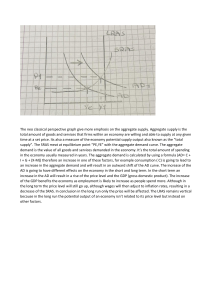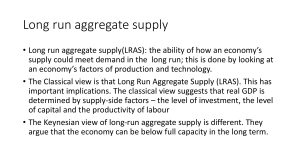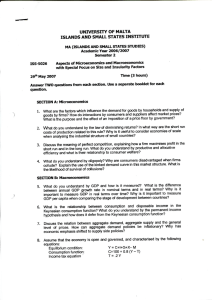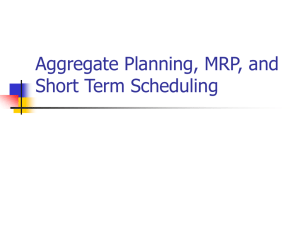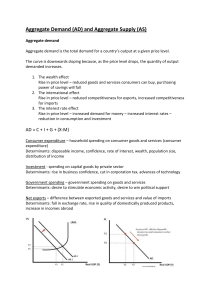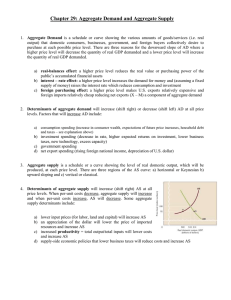57 Aggregate Demand - an introduction
advertisement
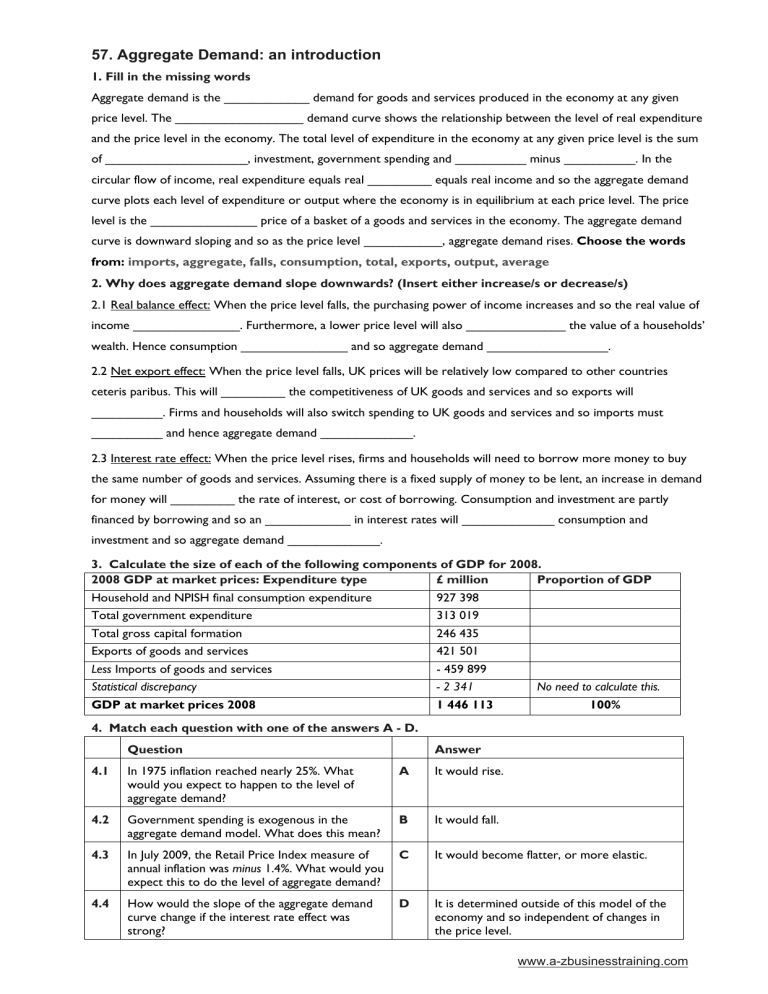
57. Aggregate Demand: an introduction 1. Fill in the missing words Aggregate demand is the ____________ demand for goods and services produced in the economy at any given price level. The __________________ demand curve shows the relationship between the level of real expenditure and the price level in the economy. The total level of expenditure in the economy at any given price level is the sum of ____________________, investment, government spending and __________ minus __________. In the circular flow of income, real expenditure equals real _________ equals real income and so the aggregate demand curve plots each level of expenditure or output where the economy is in equilibrium at each price level. The price level is the _______________ price of a basket of a goods and services in the economy. The aggregate demand curve is downward sloping and so as the price level ___________, aggregate demand rises. Choose the words from: imports, aggregate, falls, consumption, total, exports, output, average 2. Why does aggregate demand slope downwards? (Insert either increase/s or decrease/s) 2.1 Real balance effect: When the price level falls, the purchasing power of income increases and so the real value of income _______________. Furthermore, a lower price level will also ______________ the value of a households’ wealth. Hence consumption _______________ and so aggregate demand _________________. 2.2 Net export effect: When the price level falls, UK prices will be relatively low compared to other countries ceteris paribus. This will _________ the competitiveness of UK goods and services and so exports will __________. Firms and households will also switch spending to UK goods and services and so imports must __________ and hence aggregate demand _____________. 2.3 Interest rate effect: When the price level rises, firms and households will need to borrow more money to buy the same number of goods and services. Assuming there is a fixed supply of money to be lent, an increase in demand for money will _________ the rate of interest, or cost of borrowing. Consumption and investment are partly financed by borrowing and so an ____________ in interest rates will _____________ consumption and investment and so aggregate demand _____________. 3. Calculate the size of each of the following components of GDP for 2008. 2008 GDP at market prices: Expenditure type £ million Proportion of GDP Household and NPISH final consumption expenditure 927 398 Total government expenditure 313 019 Total gross capital formation 246 435 Exports of goods and services 421 501 Less Imports of goods and services - 459 899 Statistical discrepancy - 2 341 GDP at market prices 2008 1 446 113 No need to calculate this. 100% 4. Match each question with one of the answers A - D. Question Answer 4.1 In 1975 inflation reached nearly 25%. What would you expect to happen to the level of aggregate demand? A It would rise. 4.2 Government spending is exogenous in the aggregate demand model. What does this mean? B It would fall. 4.3 In July 2009, the Retail Price Index measure of annual inflation was minus 1.4%. What would you expect this to do the level of aggregate demand? C It would become flatter, or more elastic. 4.4 How would the slope of the aggregate demand curve change if the interest rate effect was strong? D It is determined outside of this model of the economy and so independent of changes in the price level. www.a-zbusinesstraining.com 57. ANSWERS: Aggregate Demand: an introduction 1. Total, aggregate, consumption, exports, imports, output, average, falls 2.1 All increase/s 2.2 Increase, increase, decrease, increase. 2.3 Increase, increase, decrease, decrease. 3 Total consumption expenditure 64% Total government expenditure 22% Total gross capital formation 17% Exports 29% Imports 32% 4.1 B 4.2 D 4.3 A (ceteris paribus) 4.4 C (Monetarist view) www.a-zbusinesstraining.com


